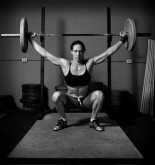Today’s post is by Monika of The Dance Training Project, which is dedicated to educating dancers, of all genres, on the importance of strength training for injury prevention, improved technical execution, and overall health and well-being, and provides training sessions and courses in downtown Toronto, Canada. Though she’s got summer on the brain, you can follow as Monika observes February Eating Disorder Awareness Month with posts and personal experiences on her own site.
I often feel like the “bad guy”.
 I’m really not, I promise. As far as nice people go, I’m probably among the top 90th percentile.
I’m really not, I promise. As far as nice people go, I’m probably among the top 90th percentile.
But in the summer I feel guilty because even though I have reason backing my suggestion, when you tell people to do the opposite of what everyone else is telling them to do it can be, well, disruptive.. While dance teachers are encouraging their students to attend summer programs, and warning them to not get out of shape, I tell them not to do so much dancing.
The Dance Training Project (DTP) summer training program, which I offer in my home city of Toronto ain’t your typical dance intensive. In fact, it’s almost the opposite, giving dancers the opportunity to train in a gym setting with a physical trainer and dancer to gain full body strength, prevent injuries, and improve dance technique.
I make sure to warn my program participants of a few things:
- Do not come to this program if you feel the want/need to dance five hours a day, and wake up at 8 am to do it all again.
- Do not come if you want to learn repertoire, to choreograph, or to build towards a final performance.
- Do not participate if you crave to be in a large class with other dancers.
- Do not come if you want to work with a famous choreographer.
I would be remiss not to mention that participating in conventional dance intensive programs can be extremely beneficial; they will help you become a better artist.
But, I can’t think of a better way to spend a summer than to begin the process of rebuilding your body from the ground up, to attempt to re-learn the way you move and to let go of hold habits accrued from years of intensive dance training, to perfect alignment and posture, build full body strength, and most importantly, give those “dancer muscles” a much needed break.
So why should you drop dancing for a few months and hit the gym, DTP style?
There are many, many reasons for dancers to strength train. I’ll try to summarize the big three:
1. Correction of muscle imbalances
- Muscle imbalances- everybody’s got ‘em, and dancers have interesting ones.
- Your hip’s external rotators are extremely tight from being turned out all day, and so you lack a significant amount of internal rotation (which is important too).
- Your quads and hip flexors are chronically tight from continuous over use.
- Your ankles lack the ability to dorsiflex, and the posterior calf muscles become tight from being on your toes so often.
- There is generally a huge discrepancy from the right side of the body to the left. Think about it, we practice things way more on the right side, and some choreography is never reversed.
And, each individual is unique. These imbalances are a recipe for becoming injured and may cause simple things, like walking, to become painful.
Accumulating so many imbalances also makes finding your proper pelvic and upper body alignment difficult, and it becomes a vicious cycle of muscles imbalances causing poor posture, causing more muscle imbalances. Ai yay yay.
2. Building strength

Is it important for dancers to be strong? No brainer, right? Yet, for some reason, dancers and their instructors are afraid to do any kind of significant strength training.
No, floor-barre and pilates are not always sufficient. There is a place for lying on the floor to strengthen the core, but the majority of the time, as a dancer, you are on your feet, moving through multiple planes. Why not strengthen your core on your feet? Things like squats, lunges, deadlifts, and push-ups will do just that.
You must however be integrated structurally before loading these movements.
Want a recipe for disaster? Give a heavy weight to a person without first making sure they understand their alignment, and have sufficient stability and mobility. Don’t do that.
Core strength is important for dancers, but often the amount and type of “core work” done in a typical dance class is insufficient. Add the fact that there are so many other things to think about while dancing, that it is easy to forget to “engage” the core musculature.
Maybe most importantly, what happens if you aren’t strong enough to perform the choreography thrown at you? Arm and leg strength is extremely important for dancers who want to execute the challenging, physical choreography of the 21st century.
-
Improved dance technique
Yes, strength training will help you dance better! And that’s the reason we do any summer program, isn’t it? To improve our technique and be better dancers after all the money, blood, sweat and tears.
Did you know that “rest” is an element of fitness? One that we ignore all too often.
Sometimes the best way to instantly improve your technical execution is to give your body a rest. A tightly coiled spring can’t coil more unless it first uncoils. Then it becomes a spring again, with all its spring-like qualities. Your body is similar.
In the case of turnout, I found that letting my external rotators rest for an entire summer allowed me to come back to dance classes able to access more turnout than I could before. By training in a parallel position, you give your dancer muscles a much deserved break. Things like turns, jumps, and developpes were much easier after having strengthened the opposing muscles, and letting the dance muscles rest.
Is the stronger dancer the better dancer? Not necessarily, but you’ll certainly have the advantage.
When your body is strong and alignment automatic, you can then let your true artistry shine through. Beautiful expression through dance is possible when you can let go of extra tension, and when you fully understand your body. This freedom and expression is what separates the men from the boys.
And so while I feel guilty telling dancers to dance less in the summer, I keep reminding myself of how one day I could only do four fouetté turns, but a month later I could do 16.
I remind myself of the way I felt when my dance teachers asked what I was doing to have improved so much in one month, and being reluctant to tell them I was lifting weights.
I remind myself how my lower back pain has all but disappeared since I began training in the gym.
This is why I founded The Dance Training Project’s summer training program. May you have a dance-less summer, too!
Monika Volkmar began dancing at age 11 at the Brandon School of Dance, in Brandon, Manitoba, training predominantly in ballet, jazz and modern dance. She has trained at such prestigious schools as The Banff Center for the Arts, the Winnipeg School of Contemporary Dancers, and Ryerson University’s dance program. While working towards her BFA in dance at Ryerson, in Toronto, Monika became certified as a personal trainer. Upon graduating, Monika founded The Dance Training Project, which specializes in providing strength and conditioning training for dancers (but also for regular people who just want to look, feel, and move better). Monika is an advocate for dancers stepping into the gym, becoming stronger, resistant to injury, and challenging their bodies in new ways.
To learn more about the DTP summer training program, go to www.danceproject.ca/summer-program.
Have you skipped the intensives to cross or strength train?
What have you been told about strength training?
Tell us in the comments!

Dance Advantage welcomes guest posts from other dance teachers, students, parents, professionals, or those knowledgeable in related fields. If you are interested in having your article published at Dance Advantage, please see the following info on submitting a guest post. Read posts from guest contributors.

